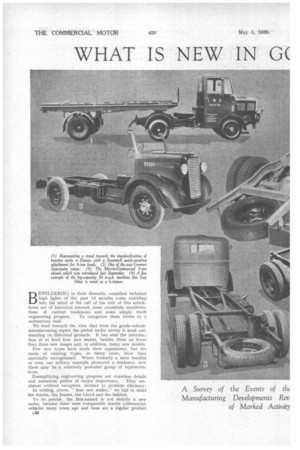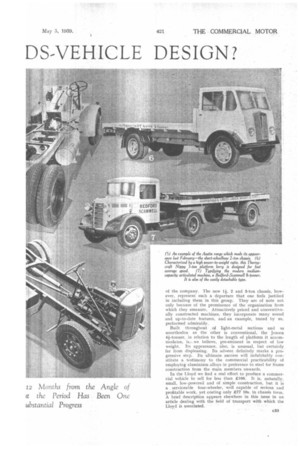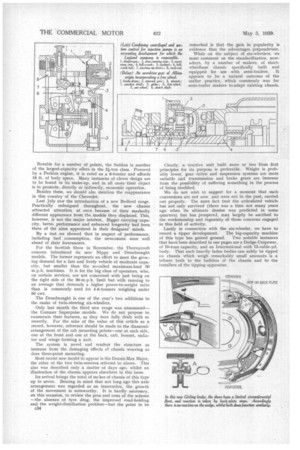WHAT IS NEW IN G( DS-VEHICLE DESIGN?
Page 82

Page 83

Page 84

Page 85

If you've noticed an error in this article please click here to report it so we can fix it.
BEIATILDERINC, in their diversity, countless technical high lights of the past 12 months come tumbling into the mind at the call of the title of this article. Some are of historical interest, some constitute manifestations of current tendencies and some simply mark
engineering progress. To categorize them looms as a momentous task.
We tend towards the view that from the goods-vehiclemanufacturing aspect the period under survey is most outstanding on historical grounds. It has seen the introduction, of at least four new makes, besides these no fewer than three new ranges and, in addition, many new models.
Few new types have made their appearance, but the ranks of existing types, in many cases, have been materially strengthened. Where formerly a mere handful or even one solitary. example pioneered a tendency, now there may be a relatively powerful group of representafives.
Exemplifying engineering progress are countless details and numerous points of major importance. They are, almost without exception. devised to promote efficiency. In writing, above, "four new makes," we had in mind the Austin, the Jensen, the Lloyd and the Seddon.
To be precise, the first-named is' not strictly a new make, because there were comparable Austin commercialvehicles many years ago and vans are a regular produCt
c32 of the company. The new 1, 2 and 3-ton chassis, however, represent such a departure that one feels justified in including them in this group. They are of note not only because of the prominence of the organization from which they emanate. Attractively priced and conventi!mally constructed machines, they incorporate many sound and up-to-date features, and an example, tested by us, performed admirably.
Built throughout of light-metal sections and as unorthodox as the other is conventional, the Jensen 4i-tonner, in relation to the length of platform it accom
modates, we believe, pre-eminent in respect of low weight. Its appearance, also, is unusual, but certainly far from displeasing. Its advent definitely marks a progressive step. Its ultimate success will indubitably constitute a testimony to the commercial practicability of employing aluminium alloys in preference to steel for frame construction from the main members onwards.
In the Lloyd we find a real effort to produce a commercial vehicle to sell for less than £100. It is, naturally, small, low-powered and of simple construction, but it is a serviceable four-wheeler, well capable of serious and profitable work, yet costing only 277 10s. in chassis form. A brief description appears elsewhere in this issue in an article dealing with the field of transport with which the Lloyd is associated. •
Notable for a number of points, the Seddon is another of the largest-capacity oilers in the 24-ton class. Powered by a Perkins engine, it is rated as a 6-tornier and affords 16 ft. of body space. Many instances of clever design are to be found in its make-up, and in all cases their object is to promote, directly or indirectly, economic operation. Besides these, we should also mention the reappearance in this country of the Chevrolet.
Last July saw the introduction of a new Bedford range. Practically redesigned throughout, the new chassis attracted attention at once because of their markedly different appearance from the, models they displaced. This, however, is not the major interest, Bigger carrying capacity, bettei performance and enhanced longevity had been three of the aims uppermost in their designers' minds.
By a test we showed that in respect of performance, including fuel consumption, the newcomers were well ahead of _their forerunners.
For the Scottish Show in November, the Thornycroft concern introduced its new Nippy and Dreadnought models. The former represents an effort to meet the grow ing demand for a fast and lively vehicle of moderate capacity, but smaller than the so-called maximum-load 30 m.p.h. machines. It is for the big class of operators, who, on certain services, are not concerned with just being on the right side of the 30-m.p.h. limit but with running to an average that demands a higher power-to-weight ratio than is commonly used for 4-6-tonners weighing under 50 cwt.
The Dreadnought is one of the year's two additions to the ranks of twin-steering six-wheelers.
Only last month the third new range was announced— the Commer Superpoise models. We do not propose to enumerate their features, as they were fully dealt with so recently. For the sake of the value of this article as a record, however, reference should be made to the diamondarrangement of the cab mounting points—one at each side, one at the front and one at the back, cab, bonnet, radiator and wings forming a unit.
The system is novel and renders the structure as immune from the damaging effects of chassis weaving as does three-point mounting.
Most recent new model to appear is the Dennis Max Major, the other of the two twin-steerers referred to above. This also was described only a matter of days ago, whilst an illustration of the chassis appears elsewhere in this issue. Its arrival brings the total of mEkes of chassis of this type up to seven. Bearing in mind that not long ago this axle arrangement was regarded as an innovation, the growth of the movement is noteworthy. It is hardly necessary, on this occasion, to review the pros and cons of the scheme —,the absence of tyre drag, the improved road-holding and the weight-distribution problem—but the point to be c34 remarked is that the gain in popularity is evidence that the advantages preponderate.
While on the subject of six-wheelers, we must comment on the standardization, nowadays, by a number of makers, of shortwheelbase chassis specifically built and equipped for use with semi-trailers. It appears to be a natural outcome of the earlier, practice, which commonly was for semi-trailer makers to adapt existing chassis.
Clearly, a tractive unit built more or less from first principles for its purpose is preferable. Weight is probably lower, gear ratios and suspension systems are more suitable and transmission and brake gears are immune from the possibility of suffering something in the process of being modified.
We do not wish to suggest for a moment that such conversions are not now, and were not in the past, carried out properly. The mere fact that the articulated vehicle has not only survived (there was a time not many years ago when its ultimate demise was predicted in some quarters) but has prospered, may largely be ascribed to the workmanship and ingenuity of those concerns engaged in this field of activity.
Lastly in connection with the six-wheeler, we have to record a tipper development. The big-capacity machine of this type has gained ground. Two notable instances that have been described in our pages are a Dodge-Unipower, of 10-tons capacity, and an International with 12-cubic-yd. body. That such heavily laden bodies can safely be tipped on chassis which weigh remarkably small amounts is a tribute both to the builders of the chassis and to the installers of the tipping apparatus. Turning again to four-wheelers, an important event of the period under review was the War Office North Wales trials, held in September. The outstanding feature of these was the amazing capabilities displayed by four-wheeldrive vehicles over rough country. On former occasions.
the machines under test by the Department have found the arduous Hl-climbs sufficiently exacting for their performances to be categorized and assessed, whilst they have not been able to negotiate moorland with complete success.
Last year matters were different, and the 1938 trials will stand out in history for the fact that the hills were almost too easy to constitute really useful tests and that the machines had been improved in respect of mobility to such an extent that the formerly almost-insuperable difficulties of the cross-country conditions had come so well within the capabilities of the types that they provided the greatest interest and value..
Producer gas has advanced by big strides. We predicted in our Goods Vehicle Special Issue of last May that " within 12 months machines using this fuel will be on our roads in fair numbers." Admittedly we were .a trifle optirhistic, but there were at the end of 1938, to the best of our knowledge, at least 23 producer-gas machines actually in use in this country, including an agricultural tractor. The subject of alternative fuels is dealt with individually in another part of this issue, but before leaving it we must make reference to experiments in progress in connection with a scheme for injecting gas under pressure, similarly to liquid fuel in a compression-ignition engine, that may lead to big developments.
A controversy between advocates of two . main engine types occupied a portion of our space not long ago. 'if he point at issue was the relatirs merits of the two-stroke and the four-stroke. Good arguments were put forward, by both camps, but the fact that no serious challenge to the almost-absolute supremacy of the four-stroke has yet appeared in this country is telling evidence.
All surveys of past events such as this must inevitably incorporate a passage justifiably headed " Miscellaneous." There is, then, practically no limit to the items it may include. That is now our difficulty. We will evade it, therefore, by excusing ourselves with the phrase "named at random." Thus there is no attempt at grading in relation to importance or even at approaching comprehensiveness.
In this miscellaneous list are the wide adoption of wedge-actuated brake shoes; the introduction by the Girling concern of floating shoes, and by more than one brake specialist of "two-leading-shoe " types— a misnomer but an expressive term ; the appearance of two highly ingenious new overdrives incorporating easy-engagement devices ; the introduction of a new dumper—the Marshall. bringing up to four the total number of makes of this handy form of vehicle, extremely popular among public-works contractors ; the steady gain of ground by the battery-electric and the improvement in tyres, resulting in an increase by makers of the recommended loadings for specific sizes.
This last has had an important influence on pay-load rating and is thus inextricably involved with the neverceasing activities of vehicle builders in increasing strength, performance, durability and economy whilst simultaneously reducing weight.
On this note we may conclude by summing up the situation with the statement that the needs of road transport are served to-day more efficiently than ever. For the functions both of peaceful commerce and of defence in emergency, the vehicle Manufacturer plays splendidly a vital part.'
































































































































































